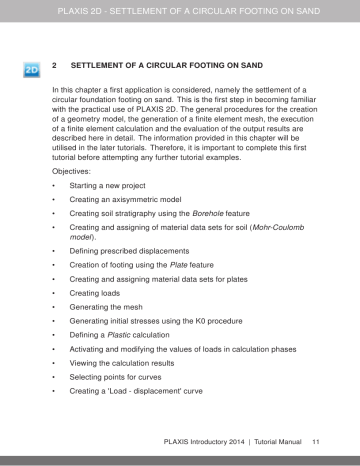

Material type Type Elastic Isotropic -Prevent punching Yes -Normal stiffness EA 1.2 107 kN/mFlexural rigidity EI 1.2 105 kNm2/mWeight w 8.3 kN/m/mPoisson's ratio 0.15 -Īssign positive and negative interfaces to the geometry lines created to representthe diaphragm walls. Table 3.2 Properties of the diaphragm wall (plate) The concrete has a Young's modulus of 35 GN/m2 and the wall is0.35 m thick.įigure 3.3 Material assignment in the Selection explorer A new empty material set is created for plates.ĭefine the material data set for the diaphragm walls according to the properties arelisted in Table 3.2.
#PLAXIS 2D TUTORIAL MANUAL PLUS#
The view will change displaying adrop-down menu and a plus button next to it (Figure 3.3).Ĭlick the plus button. In the Selection explorer click on Material. K0 determination Automatic Automatic Automatic -Over-consolidation ratio OCR 1.0 1.0 1.0 -Pre-overburden pressure POP 0.0 0.0 25.0 kN/m2 Rinter 0.65 0.70 1.0 -Consider gap closure Yes Yes Yes -Initial
#PLAXIS 2D TUTORIAL MANUAL MANUAL#
Interface strength Manual Manual Rigid -Strength reduction factor inter. Permeability in horizontal direction kx 0.5996 7.128 0.2497 m/dayPermeability in vertical direction ky 0.5996 7.128 0.2497 m/day Power for stress-level dependency ofstiffness Unloading / reloading stiffness E refur 6.0 104 9.0 104 3.6 104 kN/m2 Tangent stiffness for primaryoedometer loading Secant stiffness in standard drainedtriaxial test Soil unit weight below phreatic level sat 20 20 19 kN/m3 Soil unit weight above phreatic level unsat 16 17 17 kN/m3 Type of material behaviour Type Drained Drained Drained. Material model Model Hardening soil Hardening soil Hardening soil. The layer stratigraphy is shown in Figure 3.2.ĭefine three data sets for soil and interfaces with the parameters given in Table 3.1.Īssign the material data sets to the corresponding soil layers (Figure 3.2). The bottom levels of the layersare located at 27, 15 and 0 m, respectively. Locate the ground level at y = 30 m byassigning 30 to the Top level of the uppermost layer. The Modify soil layers window pops up.Īdd three soil layers to the borehole. Keep the default values for units and the constants and press OK to close theProject properties window.Ĭreate a borehole at x = 0. Set the model dimensions to xmin = 0.0 m, xmax = 100.0 m, ymin = 0.0 m, ymax = 30.0m. In the Model tabsheet keep the default options for Model (Plane strain), andElements (15-Node). In the Project tabsheet of the Project properties window, enter an appropriate title. Start the Input program and select Start a new project from the Quick select dialogbox. In the initial situation there is a horizontal phreatic levelat 3 m below the ground surface (i.e.

15 m of thislayer is considered in the model.

The underlying layer consists of loam and lies to a large depth. This layer is particular suitable for the installation of the groundanchors. Underneath the fill, down toa minimum depth of 15 m, there is a more or less homogeneous layer consisting of densewell-graded sand. From the ground surface to adepth of 23 m there is a fill of relatively loose fine sandy soil. The relevant part of the soil consists of three distinct layers. On the left side of the excavation a surface load of 10 kN/m2 istaken into account. The anchors have a total length of 14.5 m and aninclination of 33.7 (2:3). Two rows of ground anchors areused at each wall to support the walls. 16 m long concrete diaphragm walls of 0.35m thickness are used to retain the surrounding soil. The excavation is 20 m wide and 10 m deep. Generating pore pressures by groundwater flow.ĭisplaying the contact stresses and resulting forces in the model. This aspect of the analysis is explained indetail. Moreover, the dry excavation involves a groundwater flow calculation togenerate the new water pressure distribution. It is demonstrated in thisexample how ground anchors are modelled and how prestressing is applied to theanchors. PLAXIS allows for a detailed modelling of this type of problem. The walls are tied back by prestressed ground anchors.įigure 3.1 Excavation supported by tie back walls The excavation is supportedby concrete diaphragm walls. This example involves the dry construction of an excavation.


 0 kommentar(er)
0 kommentar(er)
